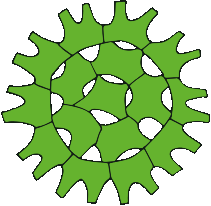Spent Friday in the capitol, Helsinki. Visited Dr. Anke Kremp, a senior researcher at the Marine Research Centre/Modelling and Innovations Unit of the at the Finnish Environment Institute (SYKE) and listened with joy to all the things she had to tell about the Dinoflagellates in the Baltic Sea: the species recorded there, identification, taxonomy and the recent changes in taxonomy.
Because of the brackish water in the Baltic Sea and the gradual changes of salinity along the Finnish coast the species assemblage has its very own character. A checklist of the Baltic phytoplankton was published in revised form in 2004 by Guy Hällfors – a list that is very useful, not least because it has a very extensive list of synonyms, older names of the species. The taxonomy of Dinoflagellates has changed a lot since 2004 and because Hällfors “tried to avoid the inflation of higher taxa”, this publication in not The One for the up-to-date names. For more recent names one can look at the wonderful The Center of Excellence for Dinophyte Taxonomy.
In Hällfors’ Checklist we find 83 species that are recorded in the Finnish parts of the Baltic sea, that is the Northern Baltic Proper, the Gulf of Finland, the Archipelago Sea, The Botnian Sea and the Botnian Bay. Most of them are in the orders Peridiniales (31) and Gymnodiniales (29).
Only 83 species. It should then not be extremely difficult to learn to know most of them. On the paper at least. In lugol samples the visibility of the critical features of Dinoflagellates is, of course, somewhat limited.
If one looks very carefully, who knows one finds some new ones too? 🙂 But before doing the dance of joy in a state of euphoria it’s better to contact a real expert. I’m looking forward to getting to know the Baltic Dino’s better!
